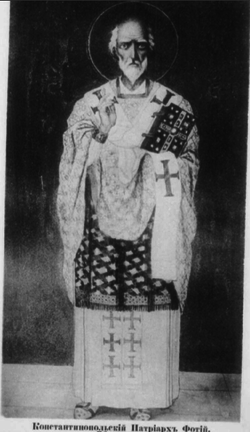Top Qs
Timeline
Chat
Perspective
February 6 (Eastern Orthodox liturgics)
From Wikipedia, the free encyclopedia
Remove ads
February 5 - Eastern Orthodox liturgical calendar - February 7

All fixed commemorations below are observed on February 19 by Eastern Orthodox Churches on the Old Calendar.[note 1]
For February 6, Orthodox Churches on the Old Calendar commemorate the Saints listed on January 24.
Feasts
- After feast of the Meeting of Our Lord.[1]
Saints
- Venerable Bukolus, Bishop of Smyrna (c. 100)[2][3][4][5]
- Martyrs Theophilus, Saturninus and Revocatus, in Spain (249-251)[6][note 2]
- Virgin-martyr Dorothea,[8][9] and with her Martyrs Christina and Callista, sisters,[10] and Theophilus, at Caesarea in Cappadocia (288-300)[2][11][12][note 3]
- Virgin-martyr Fausta, and with her Martyrs Evilasius and Maximus, at Cyzicus (305-311)[2][4][13][14]
- Martyr Julian of Emesa the Physician, and Bishop Silvanus (312)[2][4][15][16][note 4]
- Martyrs Faustus, Basil and Lucianus, of Darion in Constantinople, by the sword.[4][12][17][note 5]
- Venerable John of Lycopolis (John of Thebes), monk (4th century)[2][4][12][18]
- Saint James, ascetic, of Syria (c. 460)[2][4][12]
- Saints Barsanuphius the Great and John the Prophet, monks of Gaza (6th century)[2][4][19][20]
- Saint Photius the Great, Patriarch of Constantinople, Confessor and Equal-to-the-Apostles (891)[2][4][21][22]
- Virgin-martyrs Martha and Mary and their brother Lycarion, at Tanis (Hermopolis) in Egypt.[2][12][23] (see also February 8 - Greek)
Remove ads
Pre-Schism Western saints
- Saint Antholian (Anatolianus), mentioned by St Gregory of Tours as one of the martyrs of Auvergne in France under Valerian and Gallienus (c. 265)[7][24][note 6]
- Saint Mél of Ardagh (Mael), Bishop of Ardagh (488), disciple of St. Patrick.[2][12][24][25][26][note 7][note 8]
- Saint Mun, a nephew of St Patrick who consecrated him bishop (5th century)[24][28][note 9]
- Saint Vedast, Bishop of Arras (540)[2][12][24][29][note 10][note 11]
- Saint Amandus of Elnone Abbey, Apostle of Maastricht (675)[2][12][24][30][31][note 12]
- Saint Andrew of Elnone Abbey, a monk and disciple of St Amandus at Elnone in France, whom he succeeded as Abbot (c. 690)[24][note 13]
- Saint Relindis of Maaseik (Renildis, Renula, Renule), Abbess of Maaseik in Belgium (c. 750)[24][note 14]
- Saint Tanco of Werden (Tancho, Tatta), Abbot of Amalbarich Abbey in Saxony and eventually Bishop of Werden in Germany, martyred by pagans (808)[24]
Post-Schism Orthodox saints
- Saint Arsenius of Iqalto, Georgia (1127)[2][12][32][33]
- Hieromartyr Damaskinos (Tzagkaris) the Sinaite, martyred outside the walls of the monastery by the Mezenites (1623)[34]
- Saint Dorothea, Schema-nun, of Kashin (1629)[2][12]
- Hieromartyr Artemios the Sinaite (1822)[35][note 15]
New martyrs and confessors
Remove ads
Other commemorations
- Repose of Archbishop Theophan (Bystrov) of Poltava (1940)[2]
Icon gallery
- Virgin-martyr Fausta, with Martyrs Evilasius and Maximus.
- Saint Photius, Patriarch of Constantinople.
- The ordination of St Vedast.
- St. Amandus, Apostle of Maastricht.
- Saint Arsenius of Iqalto.
- New Hieromartyr Basil Nadezhnin.
- Theophan (Bystrov) of Poltava, as an Archimandrite.
Notes
- The notation Old Style or (OS) is sometimes used to indicate a date in the Julian Calendar (which is used by churches on the "Old Calendar").
The notation New Style or (NS), indicates a date in the Revised Julian calendar (which is used by churches on the "New Calendar"). - "At Caesarea, in Cappadocia, the birthday of St. Dorothy, virgin and martyr, who was stretched on the rack, then a long time scourged with boughs of the palm-tree, and finally condemned to capital punishment, under Sapricius, governor of that province. Her noble confession of Christ converted a lawyer named Theophilus, who was also tortured in a barbarous manner, and finally put to death by the sword."[7]
- In the Synaxarion of St Nicodemus it records the name "Silounos/Silvanus of Emesa", instead of Lucianus. However in other Synaxaria their memory is given as October 25.
- Fellow-sufferers were Sts Cassius, Maximus, Liminius and Victorinus.
- "MEL was by birth a Briton, who went to Ireland as a fellow-labourer with St. Patrick, by whom he was made Bishop of Ardagh. In some legends he is said to be one of the nephews of that great Apostle, but there is no sufficient warrant for such a tradition. According to an ancient calendar, St. Mel passed to his eternal rest on the 6th of February."[27]
- He preached with St Remigius to convert the Franks. He was Bishop of Arras-Cambrai in the north of France for nearly forty years. He instructed King Clovis for baptism, built churches and cared for the poor.
- Born near Nantes in France, he lived as a hermit in Bourges for fifteen years. At the age of thirty-three he became a bishop and preached in Flanders in Belgium, Carinthia in Austria and among the Basques in Spain. He founded many monasteries in all these places, of which the best known is Elnon near Tournai, where he went in his old age and reposed aged over ninety.
- His relics were enshrined together with those of St Amandus in 694.
- A nun together with her sister Herlindis in Valenciennes, she was gifted in embroidery and painting. On her sister's repose, she became Abbess of Maaseik in Belgium.
- Hieromartyr Artemios the Sinaite ministered at the Holy-Trinity Metochion of the monastery, in Heraklion, Crete. The saint was a member of the entourage of Hieromartyr Neophytos the Sinaite (December 20), and was martyred in the year 1822.
- See: (in Russian) Василий (Надеждин). Википедии. (Russian Wikipedia).
Remove ads
References
Sources
Wikiwand - on
Seamless Wikipedia browsing. On steroids.
Remove ads








